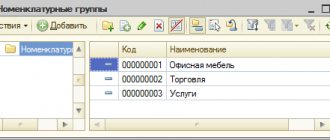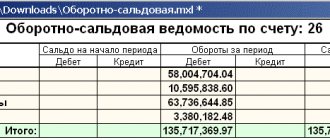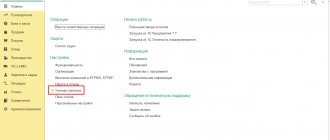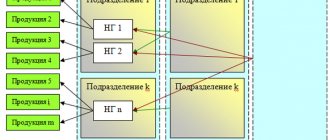Regulatory framework
The legal basis on which organizations must sell and then record goods is PBU 9/99 (Order of the Ministry of Finance of Russia No. 32n dated 05/06/1999). In it, the accountant will be able to find the answer to all questions regarding the sale of manufactured products or services provided. Organizations divide income into:
- ordinary - from the main activities;
- others - not related to the main activity, not always regular, insignificant in the total volume of profitability from the sale of products.
Ordinary income also includes profitability from trade in goods, works and services (clause 5 of PBU 9/99). The amount of income is calculated without value added tax and VAT (clause 3 of PBU 9/99). Personal income tax is also not taken into account in this case. Each institution chooses the procedure for dividing income independently, based on the specifics of the type of activity and legal form. The chosen method must be fixed in the accounting policy (clause 4 of PBU 9/99).
Clause 12 of PBU 9/99 states that revenue from trade is recognized in accounting only if the following characteristics are simultaneously determined:
- the enterprise has the right to receive it;
- it is calculated in a certain amount;
- the income is beneficial for its recipient;
- upon sale, a transfer of ownership was carried out;
- the value of sales costs is also known.
For organizations operating under a simplified accounting scheme, it is possible to recognize profitability at the time of receipt of payment for goods and services. In cases of a long production cycle, revenue can also be recognized in stages - after completing a certain stage or manufacturing a specific part (clause 13 of PBU 9/99).
Manufacturing overhead allocation
The attribution of commissioning and commissioning to the cost of manufactured products is determined not only by the requirements of financial accounting standards. Also, their inclusion in the cost is necessary to solve the problem of correct pricing.
Important!
The purpose of allocating manufacturing overhead is to determine unit costs and work in process.
As mentioned above, we cannot choose a criterion that would allow us to write off these expenses directly to the cost of a specific type of product. The solution to this problem is to select a cost factor (allocation base) that most closely matches the nature of the overhead costs of the production unit. For example, if the production process is dominated by the labor of workers, then it is advisable to use the man-hours of the main workers as the distribution base. If the manufacturing process is machine-dominated, then the machine hours of the production equipment should be used as the basis for allocating manufacturing overhead costs. In practice, the amount of direct labor costs or the number of units of production is also quite often used as the distribution base.
The commission distribution rate is calculated using the following formula:
| PNR distribution rate = | Manufacturing overhead |
| Distribution base |
Which accounts should be used to record sales?
Accounting for transactions for the sale of goods and services of an organization is reflected in account 90 “Sales” of the chart of accounts (Order of the Ministry of Finance No. 94n dated October 31, 2000). Account 90 records transactions for the sale of inventory and materials and expenses directly related to the sale of goods and materials, as well as VAT accrued on these transactions. On the account 90 you can maintain both synthetic and analytical accounting. Analytics is carried out according to such parameters as the types of industrial and technical works being sold and the structural divisions of the organization.
Account 90 has a number of sub-accounts that the organization opens based on the industry and production specifics of its scope of operation:
- revenue - 90.1;
- cost - 90.2;
- VAT - 90.3;
- excise taxes - 90.4;
- expenses - 90.5;
- profit and loss - 90.9.
Indicators and movements in subaccounts are taken into account throughout the month on an accrual basis. At the end of the reporting period - month - loan turnover (subaccount 90.1) is compared with the total debit turnover for subaccounts such as 90.2, 3, etc. The result is posted in the “Profit and Loss” subaccount with the following entry: Dt 90.9 Kt 99.
Planned and actual commissioning distribution rates
In its accounting policy, a company can choose to distribute commissions at the actual or planned (standard) rate. Both of these approaches have their advantages and disadvantages, so we will dwell on each of them in detail.
To calculate the actual rate of distribution of commissions, the following formula is used:
| Actual PNR distribution rate = | Actual commissioning |
| Actual distribution base |
Important!
A critical disadvantage of this approach is that the distribution rate can only be calculated after the closing of the reporting period, when the actual amount of overhead costs and the distribution base becomes known. Until this point, it is impossible to determine the full cost of production.
Since during the reporting period it is necessary to repeatedly evaluate the cost of inventory and justify the selling price, the use of this approach in practice is quite rare.
Due to the shortcomings of the approach to distributing production overhead costs at the actual rate, in practice, as a rule, the approach to distribution at the planned (standard) rate is used. The following formula is used to calculate it.
| Planned PNR distribution rate = | Budgetary commissioning |
| Budget distribution base |
Important!
When determining the planned rate of distribution of commissions, it is advisable to use data from the quarterly or annual budget. Longer periods allow better identification of relationships between costs and output.
The problem with this approach is that, in practice, actual manufacturing overhead costs will always differ from those budgeted, with very few exceptions. This leads to the appearance of over- or under-distributed PNR.
If the company's accounting policy assumes normal calculation of the cost of manufactured products, then the following formula is used to determine the amount of distributed commissioning.
Distributed commissions = Planned rate × Actual distribution base
How to account for sales of goods
The accounting record of sold inventory items is made at the time of shipment of goods. Accounting procedures for the sale of goods are as follows:
| Debit | Credit | Description |
| 62 | 90.1 | Revenue received from product sales |
| 90.2 | 41 | Write-off of the cost of goods sold |
| 90.5 | 44 | Write-off of costs associated with the sale |
| 51 | 62 | Receiving payment from the customer |
If, under the terms of the agreement, the transfer of ownership of sold goods and materials from the seller to the buyer is carried out at the time of payment, then, on the basis of clause 12 of PBU 9/99 (subclause “d”), revenue is not recognized at the time of delivery of the goods. When reflecting shipment and sale transactions, invoices are used. 45. Accounting entries for the sale of goods and services will be as follows:
| Posts | Transaction data |
| Dt 45 Kt 41 | Shipment of goods and materials to the customer |
| Dt 76 Kt 68 | VAT calculation |
| Dt 51 Kt 62 | Receipt of payment to the seller |
| Dt 62 Kt 90.1 | Revenue recognition |
| Dt 90.2 Kt 45 | Write-off of cost of goods and materials |
| Dt 90.3 Kt 76 | VAT credit accrued upon shipment |
| Dt 90.5 Kt 44 | Write-off of sales costs |
What is included in the costs associated with production and sales?
The list of expenses associated with the manufacture of goods and their subsequent sale is established by the Tax Code of the Russian Federation in Art. 253. Such costs include:
- expenses incurred on production;
- payment for storage of goods;
- product delivery costs;
- expenses directly related to the implementation of primary non-productive activities (works, services);
- costs of acquiring and selling commercial products, services or property rights;
- expenses for maintaining fixed assets, including payment for repairs and maintenance;
- costs incurred in the process of developing natural resource deposits;
- expenses for conducting scientific research or creating prototypes, new design developments;
- payment of amounts for voluntary and compulsory forms of insurance.
Costs incurred during the production cycle and sales phase can be divided into categories:
- Material waste.
- Remuneration of workers involved in production and sales.
- Depreciation deductions.
- Other expense transactions.
Other expenses that relate to production and sales activities are listed in Art. 264 Tax Code of the Russian Federation. They include:
- tax transfers, payment of fees and customs duties;
- payment for the certification procedure for commercial products;
- cost of legal, notary support, audit services;
- commissions;
- costs incurred in connection with the need to ensure the operability of the fire safety and security system;
- personnel search costs;
- repair and maintenance under warranty;
- regular payments under rental or financial leasing agreements;
- amounts spent on office supplies, sending correspondence, professional retraining of employees;
- the price of acquiring rights to the software;
- standardized expenses that must be attributed to the cost of goods according to calculation.
How to account for services
Services are considered transferred immediately at the time of their provision. Use the following accounting records for the sale of services:
| Accounting in accounting | Content |
| Dt 62 Kt 90.1 | Reflection of revenue |
| Dt 90.2 Kt 20, 23, 29, etc. | Write-off of cost |
| Dt 90.3 Kt 68 | VAT accrual on the price of the service provided |
| Dt 90.5 Kt 44 | Write off costs |
| Dt 51 Kt 62 | Receiving payment from the customer |
Shop and general plant commissioning distribution rates
In practice, a situation quite often occurs when the production process has a workshop structure. Provided that separate accounting of production costs is maintained by each separate production unit, the distribution of production overhead costs can be carried out at shop rates.
Important!
Since the basis for the distribution of commissioning work among production divisions can be different cost factors, the use of shop rates makes it possible to take into account as fully as possible the nature of the production overhead costs of each of them. Due to this, a more accurate estimate of the cost per unit of production and inventory is achieved.
An alternative to using shop floor rates is to use a plant-wide commission distribution rate. This approach does not require the organization of separate accounting of overhead costs by each production department. However, the cost estimate obtained as a result of its application will be less accurate, since one cost factor is selected to distribute the production overhead costs of all departments, which does not allow them to fully take into account their nature.
How the implementation is adjusted
If the terms of the contract for the supply of industrial and industrial components have been changed or the accounting department has discovered a previously made error, then the accounting of sales operations can be changed in accordance with the legally established regulations. The parties can send the accompanying documentation necessary for the adjustment by e-mail (mail), and then hand over the original documents in person.
Postings for adjusting the implementation downward:
- reversal Dt 62 Kt 90.1 - decrease in revenue;
- reversal Dt 90.3 Kt 68 - deduction for the amount of the required difference;
- reversal Dt 20 Kt 60 - reduction of the buyer’s debt;
- reversal Dt 19 Kt 60 - VAT on the amount of the difference;
- Dt 19 Kt 68 - restoration of value added tax.
Variable and fixed manufacturing overheads
A very important aspect of preparing information for the needs of management accounting is the classification of commissioning projects in relation to their relation to production volume.
Variable production overhead costs change in direct proportion to the volume of activity, and fixed manufacturing overhead costs remain unchanged (within the relevant range) as activity volumes change.
In practice, the behavior of quite a few manufacturing overhead items does not fall into any of the cases described above. Such PRPs are called conditionally variable, since although they depend on the volume of production, this dependence is not directly proportional. For further analysis of expenses in such items, their variable and constant components must be distinguished; for example, this can be done using the method of maximum and minimum values.
Important!
Classification of production overhead costs into variable and fixed is one of the stages in preparing information for the analysis of “costs - production volume - profit”.
Procedure for calculating overhead costs
Planning and accounting of all expenses, including overheads, is carried out in a certain order:
- The total amount of costs for general business activities of the company is calculated.
- The amount of overhead costs that will need to be included in the estimate per unit of each type from the product range is determined.
ATTENTION! It is necessary to take into account the legal limits for overhead costs for specific items and the standards defined by the company's internal regulations.
How to close a 44 account
The formed debit balance at the end of the reporting period must be closed. However, it is not necessary to close your account completely at the end of the month. The company independently determines the method of writing off sales expenses and consolidates the decision in its accounting policy.
Where is account 44 “Sales Expenses” written off to? Which account corresponds when creating the transaction?
To write off the organization's sales expenses, a sales account is used and an accounting entry is made:
Dt 90 Kt 44.
In other words, all sales expenses are written off to the cost of products or services. However, some types of expenses should be written off taking into account certain features:
- In industry and production, the costs of transportation and packaging of products are subject to monthly write-off. Moreover, such expenses should be distributed between types of products produced depending on their volume, weight, cost and other similar indicators.
- In trade, transportation costs must be distributed in proportion to goods sold and goods remaining in warehouses or retail premises. Write-offs are made monthly.
- In the procurement stages of agriculture, costs for the procurement of food products and raw materials, as well as livestock, poultry and young animals, are subject to monthly write-off to accounting accounts 11 and (or) 15. However, the organization must independently determine how to attribute such expenses to cost.
If the company has not determined the specifics of reflecting sales expenses in its accounting policies and in the settings of accounting programs, errors may occur as to why account 44 is not closed. To eliminate errors in accounting, it is necessary to organize additional control over the closure of such transactions. For example, it will not be possible to generate reliable reporting if account 44 is not closed during the balance sheet reformation.
In organizations engaged in trading activities, account 44 “Sales expenses” may reflect, in particular, the following expenses (distribution costs): for the transportation of goods; for wages; for rent, for the maintenance of buildings, structures, premises and equipment; for storage, part-time processing and sorting of goods; for advertising; for entertainment expenses; other expenses similar in purpose. In organizations that procure and process agricultural products (beets, milk, wool, cotton, leather raw materials, flax, livestock, poultry, etc.), account 44 “Sales expenses” can reflect, in particular, the following expenses: operating expenses ; general procurement expenses; for the maintenance of procurement and receiving points; for the maintenance of livestock and poultry at bases and reception points. Accounting on account 44 is carried out in subaccounts: 44-1 “Business expenses”; 44-2 “Distribution costs”.
Features of reflecting expenses
The main differences apply to three types of organizations: manufacturing and agricultural, trading enterprises (or acting as intermediaries), construction companies that directly procure technical materials or structures.
The main difference in recording expenses between the listed types of organizations is related to the nature of their activities. For example, sales organizations would not use account 44 for packaging or shipping costs. At the same time, the costs of storing goods at the points of sale themselves will relate specifically to this type of enterprise.
The debit of account 44 is also used to reflect the costs of an employee’s business trip if it is related to the sales of finished goods (manufacturing organization) or the main activity (trade organization). Correspondence is carried out by debit and credit of account 71 when accruing travel expenses. When paying for travel expenses, posting Dt 44 Kt 76 “Settlements with various debtors and creditors” is carried out.
Postings for the sale of property not intended for sale
In relation to other sales (not included in those related to the main activity), sales entries in accounting are made using account 91. Typically, this includes income from the rental and sale of property acquired as necessary to ensure the functioning of the legal entity, but due to for any reason that it was not sold.
On account 91, analytics by type of sales should also be organized. The financial result from them will be formed according to the same principle as on account 90:
- the credit of the account will reflect the income in its full amount (Dt 62 Kt 91);
- on debit the following will arise: VAT included in the amount of income (Dt 91 Kt 68);
- accounting value of the property being sold (Dt 91 Kt 10 (01, 04, 07, 08, 58));
- expenses associated with sales (Dt 91 Kt 23 (70, 71, 76)).
However, such entries will not have anything to do with the sale of goods, since the goods are property originally intended for sale, and they are acquired for this purpose by trading organizations, i.e. those for which trade is the main activity.
Sales process.
For reporting. period 3 JSC "Dar" gained 23,600,000 rubles. (including VAT RUB 3,600,000). The standard for advertising expenses is RUB 200,000. “23,600,000 - 3,600,000) x 1%)).
The amount spent in excess of the norm is 50,000 rubles. (250,000 - 200,000).
3JSC Dar can reduce its taxable profit by only 200,000 rubles.
The main task of account 44 is to reflect expenses on the sale of goods, manufactured products, services provided or work performed.
There are several categories of costs that can be generalized for different organizations and which are collected on account 44. These include: costs for the delivery of products, their packaging and warehousing, costs associated with logistics and transportation, rental of buildings or premises, deductions, which are established by law, advertising, etc. In this case, for example, if it is necessary to load goods onto any transport, its type does not matter; the costs of loading onto ships, trains or cars are reflected equally. However, each organization with its own specifics has slight differences in what costs will be reflected on account 44.
Results
To collect overhead expenses, accounting provides special accounts from which the accumulated amounts are written off monthly.
Manufacturing costs are always included in the cost of production. General business expenses can either be taken into account in the cost price or not be included in it, but be attributed to the accounting of financial results from sales. Selling expenses are not taken into account in the cost of production, they are always immediately attributed to the financial result and may have amounts remaining at the end of the month. You can find more complete information on the topic in ConsultantPlus. Free trial access to the system for 2 days.
Optimization of business expenses
Effectively reducing sales costs is a direct path to increased profitability and profitability. The following ways to optimize this type of expense can be identified:
- cost reduction should not be an end in itself; it is much more important to organize effective management;
- any unit of spending should bring the most effective result;
- it should be remembered that expenses are the result of both actions and inactions;
- cost reduction is impossible without corresponding costs invested in it;
- maintaining the level of spending at an optimal level is already considered successful from the point of view of economic efficiency;
- one should not skimp on expenses that will help insure against more significant costs;
- Analytical work to optimize commercial costs must be ongoing.
Selling expenses written off for sales
In case of partial write-off, the following are subject to distribution: - in organizations engaged in industrial and other production activities - costs of packaging and transportation (between individual types of shipped products on a monthly basis based on their weight, volume, production cost or other relevant indicators); - in organizations engaged in trading and other intermediary activities: - transportation costs (between the goods sold and the balance of goods at the end of each month); - in organizations that procure and process agricultural products - to the debit of accounts 15 “Procurement and acquisition of material assets” (expenses for the procurement of agricultural raw materials) and (or) 11 “Animals for growing and fattening” (expenses for the procurement of livestock and poultry).





